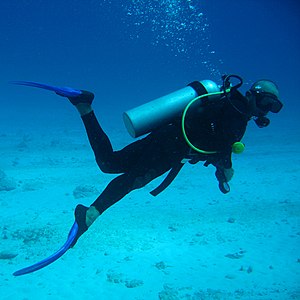DON'T CROSS THE LINE BETWEEN RECREATIONAL SCUBA AND TECHNICAL DIVING UNAWARE. TECHNICAL DIVING WASN'T REALLY COVERED IN YOUR BASIC SCUBA CERTIFICATION

PHOTO by Soljaguar released under terms of GNU Free Documentation License,
American Admiralty Books Safety & Privacy Policies
DIVER'S BOOK SHELF
First a word on technical diving generally; " a rose by any other name"
Different diving training organizations define "technical diving differently," generally accepted examples of "technical diving" include wreck diving, ice diving, and "deep" diving below 130 feet with staged decompression, and diving that requires the use of specially mixed gases vice compressed air. PADI for example pays particular attention in its definition to what's overhead. Ice, wreck, and cave diving would merit special attention in PADI programs. NOAA by contrast is more focused on decompression and gases and devotes relatively little ink to overhead considerations. Thus different "technical diving guides" take different views of what is vital to present. The view of American Admiralty Books is that "technical diving" is any diving that involves not having a free and unobstructed and uncomplicated ascent to the surface. Thus all forms of obstructed overhead diving such as wreck, ice, and cave diving are "technical." We also believe that an "uncomplicated ascent" means just that. If a dive requires staged decompression, even if only compressed air is used, the ascent is complicated and thus "technical". If the dive requires special gas mixtures beyond compressed air it is "technical." In our view "Technical" = Formal hands on, in water, instruction needed followed by some guided experience before planning your own technical underwater excursions..
Dives in open water between 34 and 130 feet are sort of a gray area to us somewhere between "technical" and "advanced recreational." Our reason for seeing this as a gray area is that if such dives are planned with formally computed short bottom times, staged decompression can be avoided. Still we would recommend that recreational divers should attempt such short bottom time dives only with an experienced instructor until they are confident in their ability to use the decompression tables, plan their dive and dive their plan. A miscalculation on such dives can be fatal. The reason we see this as a "gray area" is that the tables are part of basic diver certification in most programs and many dive shops and services offer such dives as instructor led programs but not as part of a "technical diving course." Really, other than this gray area between 34 and 130 feet, and perhaps shallower dives in extremely limited visibility where instructors routinely lead groups of basically certified divers we see anything below 33 feet in clear open water as "technical" meaning that the basically certified diver should seek out formal instruction in the particular type of dive to be undertaken. There is no one size fits all technical diving course.
The same is true for technical diving "guides." There are many different "guides" all proceeding from different views of what constitutes "technical diving." American Admiralty Books does not "suggest" or recommend any of the guides we review simply because we encourage specific and competent hands on and in the water instruction and instructor led experience before undertaking any dive remotely "technical in nature". We provide descriptions of technical diving manuals because if you join a class there may be a required manual. If you are seeking a class such a manual may give you a more informed view of what is involved and what to look for in the way of instruction. Far be it from us to discourage reading. However, If you have read this far and still think that you can read a book and go out and do a technical dive; MOVE AWAY FROM THE BOOK SHELF, GET OUT OF MY STORE!
American Admiralty Books Safety & Privacy Policies
American Admiralty Books Safety & Privacy Policies
For a further discussion of the flexible definition of "technical diving" click on this link:http://en.wikipedia.org/wiki/Technical_diving
BE SAFE: DROWNING IS A HORRIBLE DEATH. DEVELOP A LIFE LONG INTEREST IN PREVENTING DROWNING AND IN WATER DEATH BY HYPOTHERMIA BY REGULARLY VISITING THE MARIO VITTONE "BE SAFE BLOG". MARIO IS A FORMER COAST GUARD RESCUE SWIMMER WHO WILL KEEP YOU INFORMED ABOUT STAYING SAFE ON THE WATER: http://mariovittone.com/ Visit our TECHNICAL DIVING SECTION for instructional books, videos, most importantly contact information for schools and instructor led technical diving experiences.
Especially if you are a newly certified recreational diver keep those unsupervised dives above 33 feet in clear water with no overhead instructions. When you feel confident in the water plan your expansion into the technical realm around not only reading, but also additional formal instruction and initially instructor led progressive experiences.
American Admiralty Books Safety & Privacy Policies
THE DIVE SHOP
BE SAFE: DROWNING IS A HORRIBLE DEATH. DEVELOP A LIFE LONG INTEREST IN PREVENTING DROWNING AND IN WATER DEATH BY HYPOTHERMIA BY REGULARLY VISITING THE MARIO VITTONE "BE SAFE BLOG". MARIO IS A FORMER COAST GUARD RESCUE SWIMMER WHO WILL KEEP YOU INFORMED ABOUT STAYING SAFE ON THE WATER: http://mariovittone.com/ Visit our TECHNICAL DIVING SECTION for instructional books, videos, most importantly contact information for schools and instructor led technical diving experiences.
Especially if you are a newly certified recreational diver keep those unsupervised dives above 33 feet in clear water with no overhead instructions. When you feel confident in the water plan your expansion into the technical realm around not only reading, but also additional formal instruction and initially instructor led progressive experiences.
American Admiralty Books Safety & Privacy Policies
No comments:
Post a Comment